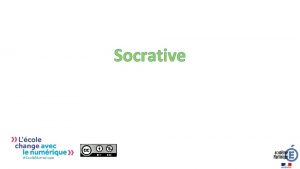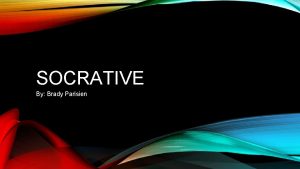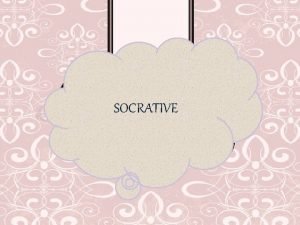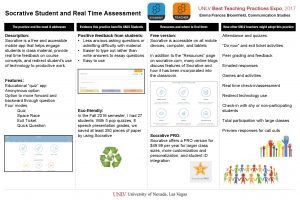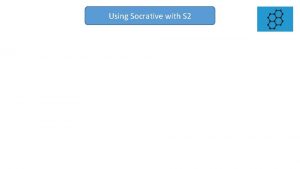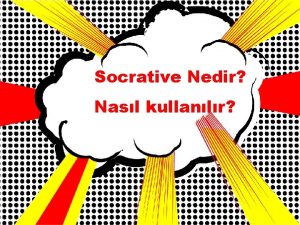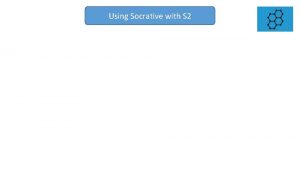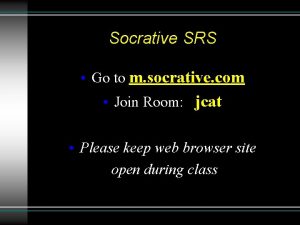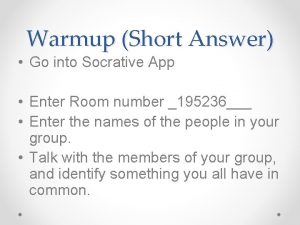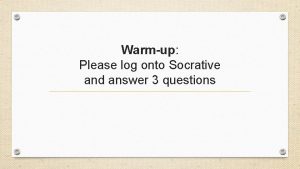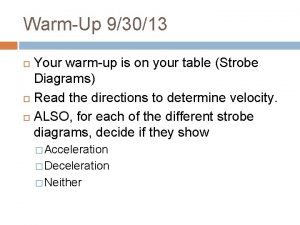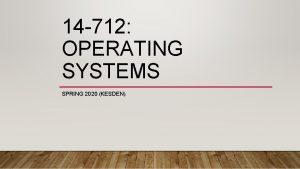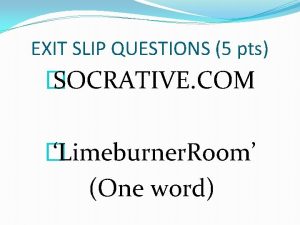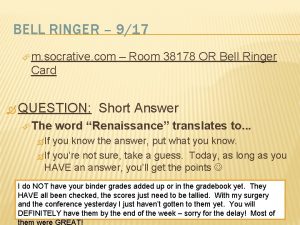Warmup n Go to Socrative for your warmup























- Slides: 23

+ Warm-up n Go to Socrative for your warm-up n Late Flash cards, reading guides & videos go here on the cart. n Get ready for homework questions. n R. E. D.

+ Chapter 4: Designing Studies Section 4. 2 Experiments The Practice of Statistics, 4 th edition – For AP* STARNES, YATES, MOORE

+ Chapter 4 Designing Studies n 4. 1 Samples and Surveys n 4. 2 Experiments n 4. 3 Using Studies Wisely

+ Section 4. 2 Experiments Learning Objectives After this section, you should be able to… ü DISTINGUISH observational studies from experiments ü DESCRIBE the language of experiments ü APPLY the three principles of experimental design ü DESIGN comparative experiments utilizing completely randomized designs and randomized block designs, including matched pairs design

n How Experiments are the preferred method for examining the effect of one variable on another. By imposing the specific treatment of interest and controlling other influences, we can pin down cause and effect. Good designs are essential for effective experiments, just as they are for sampling. Experiment n to Experiment Badly page 235 Example, page 236 A high school regularly offers a review course to prepare students for the SAT. This year, budget cuts will allow the school to offer only an online version of the course. Over the past 10 years, the average SAT score of students in the classroom course was 1620. The online group gets an average score of 1780. That’s roughly 10% higher than the long- time average for those who took the classroom review course. Is the online course more effective? Students -> Online Course -> SAT Scores

n How Many laboratory experiments use a design like the one in the online SAT course example: Experimental Units Treatment Measure Response In the lab environment, simple designs often work well. Field experiments and experiments with animals or people deal with more variable conditions. Outside the lab, badly designed experiments often yield worthless results because of confounding. Experiment n to Experiment Badly

n How n The remedy for confounding is to perform a comparative experiment in which some units receive one treatment and similar units receive another. Most well designed experiments compare two or more treatments. n Comparison alone isn’t enough, if the treatments are given to groups that differ greatly, bias will result. The solution to the problem of bias is random assignment. Definition: In an experiment, random assignment means that experimental units are assigned to treatments at random, that is, using some sort of chance process. Experiments to Experiment Well: The Randomized Comparative Experiment page 236

Pg 254 #58 To draw conclusions, we would need to make the $500 bonus offer to some people and not to others during the same time frame and compare the two groups. Experiments There was no control group for comparison purposes this year. Over a year, many things can change; the state of the economy, hiring costs (due to an increasing minimum wage or the cost of employee benefits) etc.

n The Randomized Comparative Experiment Group 1 Experimental Units Experiments Definition: In a completely randomized design, the treatments are assigned to all the experimental units completely by chance. Some experiments may include a control group that receives an inactive treatment or an existing baseline treatment. Treatment 1 Compare Results Random Assignment Group 2 Treatment 2

Pg 254 #60 Experiments a) Write all names on slips of paper, place in a container, and mix thoroughly. Select one slip and assign that name to treatment 1. Select another name and assign to treatment 2. Assign the 3 rd name to treatment 3. And so on for the 6 treatments. Rotate through the treatments until all have been assigned. b) Assign the students numbers between 001 and 150. Pick a spot on Table D & read the first 25 numbers between 001 & 150, skipping repeats or any numbers that are not between 001 & 150. These are assigned to treatment 1. Assign the next 25 numbers to treatment 2 & so on for the 6 treatments.

Pg 254 Experiments 60 c) Assign the students numbers between 1 and 150. Using the Rand. Int function on the calculator, ignoring all repeats, assign the first 25 numbers to treatment 1. Assign the next 25 numbers to treatment 2 & so on for the 6 treatments.

Pg 255 #62 a) Completely Randomized Design Group 1 6 plots 18 plots Random Assignment Treatment 1 added water winter Group 2 6 plots Treatment 2 added water spring Group 3 6 plots Treatment 3 no added Water Compare total plant biomass

Pg 254 Experiments 62 b) Label the plots 1 -18. Write labels on 18 identical slips of paper, place in a hat, and mix well. Draw 6 slips and assign those plots to Group 1. Draw 6 more slips and assign to Group 2. Put the remaining 6 plots in Group 3.


n Three Randomized comparative experiments are designed to give good evidence that differences in the treatments actually cause the differences we see in the response. Principles of Experimental Design 1. Control for lurking variables that might affect the response: Use a comparative design and ensure that the only systematic difference between the groups is the treatment administered. 2. Random assignment: Use impersonal chance to assign experimental units to treatments. This helps create roughly equivalent groups of experimental units by balancing the effects of lurking variables that aren’t controlled on the treatment groups. 3. Replication: Use enough experimental units in each group so that any differences in the effects of the treatments can be distinguished from chance differences between the groups. Experiments n Principles of Experimental Design page 240

n Example: Read the description of the Physicians’ Health Study on page 241. Explain how each of the three principles of experimental design was used in the study. A placebo is a “dummy pill” or inactive treatment that is indistinguishable from the real treatment. Experiments n The Physicians’ Health Study page 241

Pg 255 #64 + 64 a)There may be lurking variables that have changed over time. b) Randomly divide the 120 rural schools into two groups. In one group, offer the teacher better pay for good attendance. In the other group, do nothing. At the end of the study period, compare the attendance of the teachers. Experiments

Experiments 66) In a controlled scientific study, the effects of factors other than the nonphysical treatment (e. g. the placebo effect, differences in the prior health of the subjects) can be eliminated or accounted for, so that the differences in improvement observed between the subjects can be attributed to the differences in treatments. + Pg 255 68) Plan B. If he uses Plan A and discovers that the plants that had weed killer X applied did better, he will not know if this is because of weed killer X or because these were the healthier plants to begin with.

What Can Go Wrong? page 242 The logic of a randomized comparative experiment depends on our ability to treat all the subjects the same in every way except for the actual treatments being compared. n Good experiments, therefore, require careful attention to details to ensure that all subjects really are treated identically. A response to a dummy treatment is called a placebo effect. The strength of the placebo effect is a strong argument for randomized comparative experiments. Whenever possible, experiments with human subjects should be double-blind. Definition: In a double-blind experiment, neither the subjects nor those who interact with them and measure the response variable know which treatment a subject received. Experiments n + n Experiments:

for Experiments page 244 In an experiment, researchers usually hope to see a difference in the responses so large that it is unlikely to happen just because of chance variation. n We can use the laws of probability, which describe chance behavior, to learn whether the treatment effects are larger than we would expect to see if only chance were operating. n If they are, we call them statistically significant. Definition: An observed effect so large that it would rarely occur by chance is called statistically significant. A statistically significant association in data from a well-designed experiment does imply causation. Experiments n + n Inference

+ The placebo effect

b) No, if a patient is told that she is receiving a placebo, she may not experience any pain relief. Experiments 70) a) There will be nothing to compare the responses to. The placebo effect may lead some subjects to report a decrease in pain even if the new drug is ineffective. + Pg 256

n v v v Read pg 242 -252 Do pg 253 #57 - 69 odd + n Reading Guide Section 4. 2 #17 -24 Chapter 4 Vocabulary Flash Cards Estimated Test Date is Friday, February 12.
 Gmass warmup
Gmass warmup Properties warmup
Properties warmup Tom schwartz tinman
Tom schwartz tinman Stratified warmup
Stratified warmup Java warmup
Java warmup Warmup ratio
Warmup ratio Warmup 65
Warmup 65 Surface area warm up
Surface area warm up Define:warmup
Define:warmup Warmup 65
Warmup 65 Warmup end
Warmup end Rhyme glow
Rhyme glow Persuasive essay quotes
Persuasive essay quotes Give us your hungry your tired your poor
Give us your hungry your tired your poor Mantel som bars av kvinnor i antikens rom
Mantel som bars av kvinnor i antikens rom Tidböcker
Tidböcker Datumr
Datumr Orubbliga rättigheter
Orubbliga rättigheter Bamse för de yngsta
Bamse för de yngsta Verktyg för automatisering av utbetalningar
Verktyg för automatisering av utbetalningar Ministerstyre för och nackdelar
Ministerstyre för och nackdelar Tillitsbaserad ledning
Tillitsbaserad ledning Vem räknas som jude
Vem räknas som jude Expektans
Expektans
























